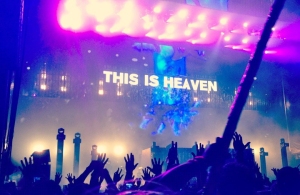Can we locate punctum in a live performance?
Above&Beyond, a UK trance trio, bet the cathartic climax of their concert tour on it.
This post considers how the act inventively deploys the meme form to incite an emotional response in the context of performance.
But first – Roland Barthes’ punctum refers to the element of a photograph that incites an emotional response via spatial immediacy coupled with temporal anteriority. Mikko Villi further interprets the punctum for the smartphone era by swapping time with distance; time no longer separates us from our photographs, now distance causes that sentimental sting.
But how does this translate to a live performance?
Above&Beyond distinguish themselves from other acts in part by employing communicative graphics that reconfigure the trio as a godlike authority (even using their image/text to declare: “This is heaven”) and the audience as a community rooted in optimism; these transient image/text combinations resemble meme images but with notable differences: (1) the viewer can see each letter being typed, (2) the meme does not require meme literacy, (3) the meme-maker writes from an authoritative position to a captive audience, and (4) there is a physical and musical component to the image/text further suggesting transiency.
There is a particular moment of elation in each performance (the finale) when the act turns the camera on the audience, and projects their live image onto the screen. In this instance, the text reads: “Life is made of small moments like these.” Above&Beyond play the video back in real time as a type of mirror in which all movement from the crowd is instantly viewable; in their authoritative position, the trio appropriate the crowd’s likeness and imbue it with the meaning of the medium – the screen is a focal point of attention, a method for communication, and a signifier of the trio’s deity-like ‘voice’.
While Barthes states that “time eliminates the emotion of loss”, in this case the sense of loss is felt in the anticipation of the accumulation of time and distance, and the death of the moment (75). This-has-been is instead this-currently-is, but contrary to Villi, a sense of distance is not a cause for sentimentality. How could it be, when the viewer is experiencing an image of their exact location and time? Discouraging the use of recording devices, the trio believes in the sanctity of the moment; the moment stings as it ends – in a performative context, the punctum can sting without record of existing.
Barthes, Roland. Camera Lucida: Reflections on Photography. New York: Hill and Wang, 1981. 42-60. Print.
Villi, Mikko. “Distance as the New Punctum”. Digital Snaps: The New Face of Photography. ed. Jonas Larsen and Mette Sandbye. London: I.B. Tauris, 2014. 47-64. Print.



Discussion
No comments yet.